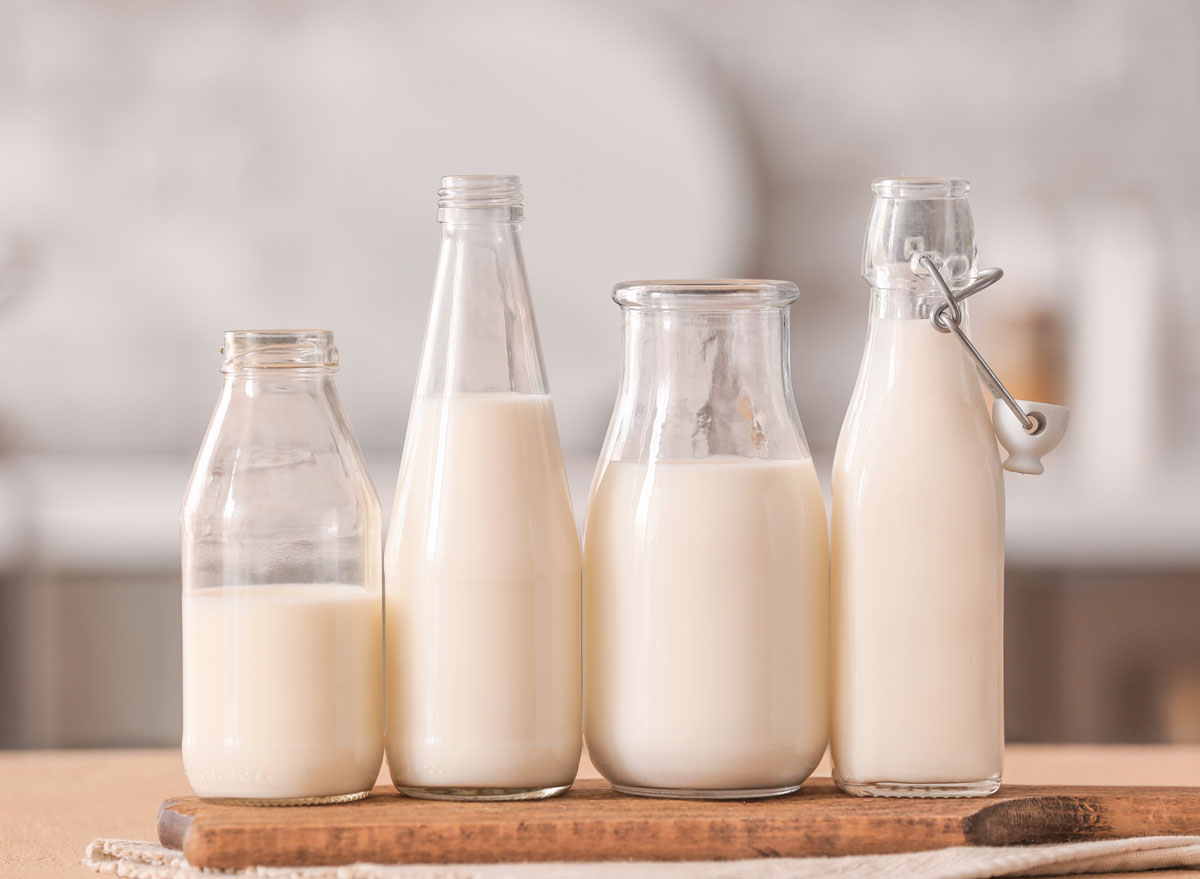Organic vs. Regular Milk: Which One Is Better For You?

Americans drink about half a cup of dairy milk every day, according to 2019 data from the USDA. Considering milk is still a breakfast mainstay, should you consider splurging on an organic carton instead of sipping on the conventional stuff?
Here, we finally settle the debate on whether organic milk is better than regular (psst, the verdict just might save you a few bucks). And before buying a gallon, check out these 4 Surprising Effects of Drinking Milk.
What is organic vs. regular milk?
Cows must be organic in order to produce organic milk. And unlike conventional dairy production, organic dairy farms are subject to follow specific criteria, according to the USDA:
- Organic cows can't be given growth hormones or antibiotics (unless the animal is sick)
- Feed must be 100 percent organic
- Cows have access to graze on pasture at least 120 days a year
As for antibiotics, there are exceptions that ensure the ethical treatment of the cows. Dairy producers are allowed to treat sick cows with antibiotics or other drugs; however, treated cows are no longer considered organic and must be sold off to a non-organic facility, according to the USDA.
Should you be concerned about antibiotics in conventional milk?
At the end of the day, the milk you buy at the store—whether that's organic or regular milk—is completely antibiotic-free. That's because the USDA doesn't allow milk that tests positive for antibiotic residue to make it to stores, according to Mississippi State University Extension. So rest assured that the organic and non-organic milk in your grocery store's dairy aisle is completely free of antibiotics.
And that goes for safe pesticide levels, too. The USDA Pesticide Data Program evaluates both conventional and organic dairy and makes sure that all pesticide residues in all types of dairy milk are much lower than established limits, per Mississippi State University Extension.
Organic vs. Regular Milk Nutrition

Many folks buy organic milk because they think it's nutritionally superior. However, research shows that may not be the case.
According to a 2016 study in the British Journal of Nutrition, organic milk has more vitamin E, iron, and healthy polyunsaturated fats (most notably, omega-3s), but it's lower in iodine and selenium. Still, milk isn't a significant source of either vitamin E or iron, so you're better off getting those nutrients from vitamin E-rich foods, such as almonds and sunflower seeds, and iron-rich foods, such as beans and salmon.
While the British Journal of Nutrition study found that organic milk is higher in heart-healthy omega-3 fatty acids, that doesn't really matter if you're buying anything other than whole milk. Skim, low-fat, or reduced-fat milk gets the fats removed during the manufacturing process, so only whole milk retains the fatty acid profile.
But that doesn't mean you should be shelling out for organic whole milk. Whole milk dairy isn't nutritionally better for you than skim milk. A 2017 study in the journal Beverages concluded that drinking organic milk over conventional milk doesn't come with any substantial health benefits.
What's more, both organic and conventional milk is fortified with vitamin D, as required by the FDA, so you're sure to get this important nutrient from any type of cow's milk you choose, which may not be the case if you're consuming non-dairy milk alternatives.
Buying Conventional Milk Can Save You Money
We know your grocery bill is sky-high right now, so save your cash and skip the organic milk. In February 2023, the USDA reported that a gallon of conventional whole milk was priced at an average of $4.38 while a half gallon of organic whole milk was $4.81—that's more than twice as much for an organic jug.
Organic milk has a higher price tag because raising organic dairy cows has higher costs when it comes to animal feed prices and organic certification costs, according to Mississippi State University Extension. What's more, organically raised cows produce about 15 percent less milk than conventionally raised cows because organic producers can't use the same fertilizers to boost the cows' feed, which is another reason why organic milk costs more.
The Bottom Line
There are no significant nutritional differences between organic and conventional milk. Both organic and non-organic milk are completely antibiotic-free, and the USDA ensures that pesticide residues that are left over in milk are much lower than established limits.
If milk is a staple in your household, buying a non-organic jug can save you money at the grocery store.
- Source: https://www.ers.usda.gov/amber-waves/2022/june/fluid-milk-consumption-continues-downward-trend-proving-difficult-to-reverse/
- Source: https://www.usda.gov/media/blog/2012/04/26/organic-101-lifecycle-organic-food-production
- Source: https://www.ncbi.nlm.nih.gov/pmc/articles/PMC4838834/
- Source: https://www.mdpi.com/2306-5710/3/3/39
- Source: https://ift.onlinelibrary.wiley.com/doi/full/10.1111/1750-3841.13648#:~:text=Reduced%20fat%20and%20skim%20milks,a%20minimum%20of%20400%20IU.







